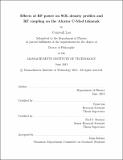| dc.contributor.advisor | Yijun Lin and Earl S. Marmar. | en_US |
| dc.contributor.author | Lau, Cornwall (Cornwall HongMan) | en_US |
| dc.contributor.other | Massachusetts Institute of Technology. Department of Physics. | en_US |
| dc.date.accessioned | 2014-01-09T19:59:05Z | |
| dc.date.available | 2014-01-09T19:59:05Z | |
| dc.date.issued | 2013 | en_US |
| dc.identifier.uri | http://hdl.handle.net/1721.1/83824 | |
| dc.description | Thesis (Ph. D.)--Massachusetts Institute of Technology, Dept. of Physics, 2013. | en_US |
| dc.description | Cataloged from student-submitted PDF version of thesis. | en_US |
| dc.description | Includes bibliographical references (pages 192-203). | en_US |
| dc.description.abstract | A 100-146GHz swept-frequency X-mode reflectometer constructed and installed at three poloidal locations adjacent to the lower hybrid (LH) launcher and one location adjacent to the new field aligned ion cyclotron range of frequencies (ICRF) antenna has been used to measure the scrape-off-layer (SOL) density profiles under a wide range of plasma parameters in order to study plasma-antenna coupling and non-linear RF-SOL interactions on Alcator C-Mod. After validating the reflectometer density profiles with other density profile diagnostics in easily diagnosed and well understood plasma conditions, detailed reflectometer density profile measurements in plasmas with application of ICRF, LH and ICRF+LH power will be shown in order to understand the physical mechanisms for RF-induced density profile modifications. Results indicate that both ICRF and LH power create significant poloidal density profile asymmetries that are correlated with video camera emissivity measurements. These results will be shown to depend on various plasma parameters such as launched nll of the LH waves, ICRF antenna location, and toroidal magnetic field direction. Both LH and ICRF power have been experimentally observed to modify the poloidal flow in the SOL. These flows are reminiscent of LH and ICRF induced convective cells that have been discussed in the literature. A 2-D diffusive-convective model has been applied to quantify the effects of these RF-induced ExB drifts on the SOL density profiles. For the LH case, the simulation reproduces the experimental trends at all three reflectometer poloidal locations adjacent to the LH launcher and indicates that LH-induced ExB drifts is the dominant physical mechanism producing the experimentally measured density profile modifications. Understanding this RF-induced transport helps elucidate these nonlinear RF-SOL mechanisms. One consequence of these density profile modifications is a change in LH coupling efficiency. A 2-D slab LH coupling model has also been used to quantify the effects of the density profile modifications on LH coupling. It will be shown that LH coupling is extremely sensitive to the edge density profile and to poloidal asymmetries in the density profiles. The inclusion of LH and ICRF-induced ExB drift effects on the observed density profile asymmetries is necessary to understand the experimentally measured LH coupling results during LH only and LH+ICRF operations. | en_US |
| dc.description.statementofresponsibility | by Cornwall Lau. | en_US |
| dc.format.extent | 203 pages | en_US |
| dc.language.iso | eng | en_US |
| dc.publisher | Massachusetts Institute of Technology | en_US |
| dc.rights | M.I.T. theses are protected by
copyright. They may be viewed from this source for any purpose, but
reproduction or distribution in any format is prohibited without written
permission. See provided URL for inquiries about permission. | en_US |
| dc.rights.uri | http://dspace.mit.edu/handle/1721.1/7582 | en_US |
| dc.subject | Physics. | en_US |
| dc.title | Effects of RF power on SOL density profiles and RF coupling on the Alcator C-Mod tokamak | en_US |
| dc.title.alternative | Effects of radio-frequency power on scrape-off-layer density profiles and radio-frequency coupling on the Alcator C-Mod tokamak | en_US |
| dc.type | Thesis | en_US |
| dc.description.degree | Ph.D. | en_US |
| dc.contributor.department | Massachusetts Institute of Technology. Department of Physics | |
| dc.identifier.oclc | 865576317 | en_US |
